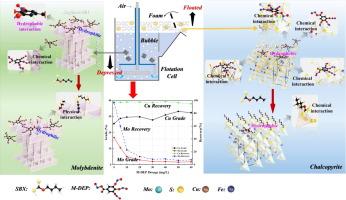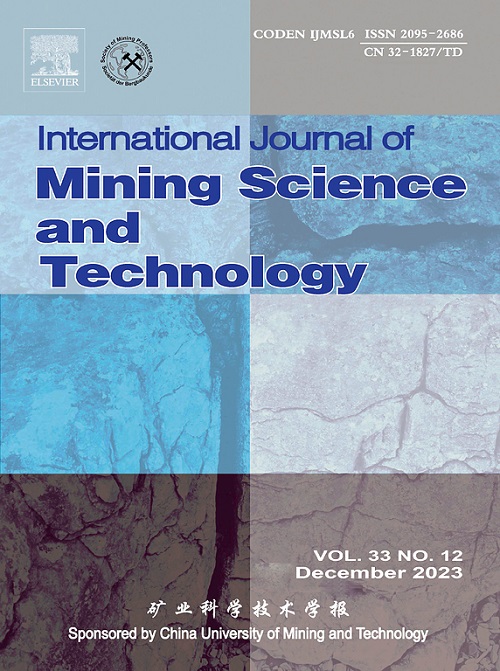A novel molybdenite depressant for efficient selective flotation separation of chalcopyrite and molybdenite
IF 11.7
1区 工程技术
Q1 MINING & MINERAL PROCESSING
International Journal of Mining Science and Technology
Pub Date : 2024-08-01
DOI:10.1016/j.ijmst.2024.08.009
引用次数: 0
Abstract
A novel small molecule depressant (M-DEP) was used to separate chalcopyrite and molybdenite via flotation. The results showed that M-DEP had an excellent selective depression on molybdenite, while had little effect on the flotation of chalcopyrite. The adsorption capacity of M-DEP on the surface of molybdenite was greater than that on chalcopyrite surface. The adsorption of M-DEP reduced the floatability of molybdenite and had less effect on the floatability of chalcopyrite, which was due to its different adsorption modes on the surface of the two minerals. Furthermore, the interaction between chalcopyrite and M-DEP was mainly chemical interaction, and almost all of the adsorbed M-DEP molecules were removed and replaced by sodium butyl xanthate (SBX). By contrast, hydrophobic interaction was the main way in which M-DEP was adsorbed on the molybdenite surface with little chemical interaction, which was less interfered by SBX addition. Therefore, M-DEP had a super selective depression on molybdenite. The study provided a novel depressant and approach for the deep separation of chalcopyrite and molybdenite via flotation.

用于高效选择性浮选分离黄铜矿和辉钼矿的新型辉钼矿抑制剂
一种新型小分子抑制剂(M-DEP)被用于通过浮选分离黄铜矿和辉钼矿。结果表明,M-DEP 对辉钼矿有很好的选择性抑制作用,而对黄铜矿的浮选影响很小。M-DEP 在辉钼矿表面的吸附能力大于在黄铜矿表面的吸附能力。M-DEP 的吸附降低了辉钼矿的可浮性,而对黄铜矿的可浮性影响较小,这是因为 M-DEP 在两种矿物表面的吸附模式不同。此外,黄铜矿与 M-DEP 之间的相互作用主要是化学作用,几乎所有吸附的 M-DEP 分子都被黄原酸丁酯钠(SBX)去除和取代。相比之下,疏水作用是 M-DEP 吸附在辉钼矿表面的主要方式,化学作用很少,SBX 的加入对其干扰较小。因此,M-DEP 对辉钼矿具有超强的选择性抑制作用。这项研究为通过浮选深度分离黄铜矿和辉钼矿提供了一种新型抑制剂和方法。
本文章由计算机程序翻译,如有差异,请以英文原文为准。
求助全文
约1分钟内获得全文
求助全文
来源期刊

International Journal of Mining Science and Technology
Earth and Planetary Sciences-Geotechnical Engineering and Engineering Geology
CiteScore
19.10
自引率
11.90%
发文量
2541
审稿时长
44 days
期刊介绍:
The International Journal of Mining Science and Technology, founded in 1990 as the Journal of China University of Mining and Technology, is a monthly English-language journal. It publishes original research papers and high-quality reviews that explore the latest advancements in theories, methodologies, and applications within the realm of mining sciences and technologies. The journal serves as an international exchange forum for readers and authors worldwide involved in mining sciences and technologies. All papers undergo a peer-review process and meticulous editing by specialists and authorities, with the entire submission-to-publication process conducted electronically.
 求助内容:
求助内容: 应助结果提醒方式:
应助结果提醒方式:


